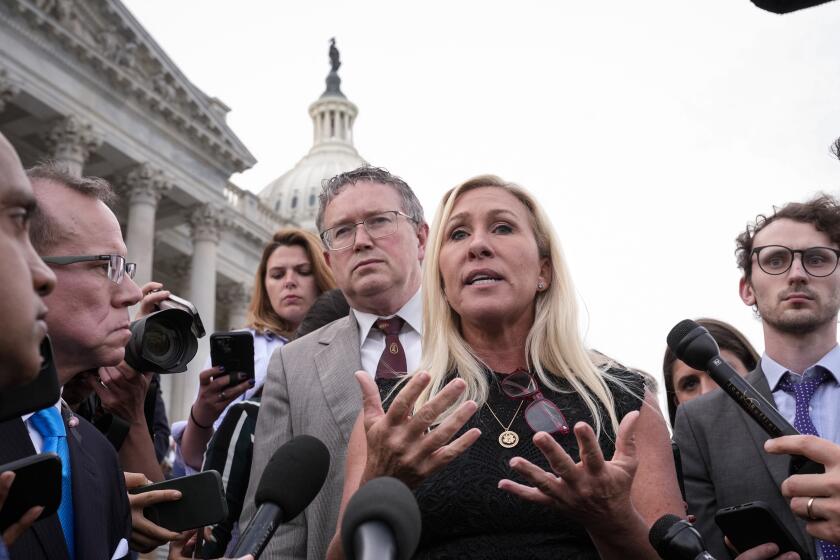Africa’s Biggest Hospital Provides Little Relief for Ailing Black Citizens
In an intensive-care unit at Baragwanath, Africa’s biggest hospital, some of the world’s best technology is keeping a black infant alive in a fight against pneumonia.
But just 200 yards down a walkway, doctors say, other black patients are dying because overworked nurses fail to dispense drugs on time.
While a million-dollar computed tomograph (CAT) scanner gives radiologists a video view of 70-year-old Rosinah Tlhapi’s tuberculosis-damaged spine, patients within crying distance in this showcase of black medical care are sleeping--and dying--on thin mattresses on the floor.
And all the while, not that far away on a scenic ridge overlooking exclusive--meaning white--Parktown, under-used Johannesburg Hospital has 1,500 empty beds that are denied by apartheid to blacks crowded into Baragwanath.
“The people who live in Soweto make a major contribution to the wealth of the city, and they are as entitled as any retired white to the same kind of benefits in health care,” said a senior white specialist who asked that his name not be used.
Tradition of Medical Care
“There is a wonderful tradition of medical care in this country, and we want to keep it that way,” the specialist said. “No patient should have to sleep on the floor just because he is black. No white patient would be made to sleep on a hospital floor.”
Those sentiments may yet lose the specialist his job at Baragwanath.
About 95 senior doctors, interns and trainee specialists at the giant black hospital are under threat of dismissal unless they recant their public damning of “human suffering which cannot be portrayed by mere statistics.”
“The attitude of the responsible authorities can only be described as deplorable,” the doctors said in a signed letter published in the prestigious South African Medical Journal. “Conditions in the medical wards at the hospital are disgusting and despicable. . . . The state of affairs is inhumane.”
The doctors attacked low funding, understaffing and years of official “indifference and callous disregard.”
Some Have Apologized
State hospital chiefs threatened the signatories with dismissal unless they signed written retractions. About 40 young doctors and interns, fearing damage to their careers, have signed apologies.
Forty-year-old Baragwanath Hospital’s 10-level administration block and 1,300-room nurses’ residence are the tallest buildings in Soweto, a sprawling, low-rise city of 2 million blacks on Johannesburg’s southeastern fringe.
Officials shepherding reporters on a tour of the 170-acre complex dispense statistics with pride: 1.5 million patients a year, 3 tons of laundry daily, 2,700 beds, 30,000 babies delivered each year, 7 miles of corridors and walkways, 10,000 staff, 620 doctors.
“It’s the largest hospital in Africa and the Southern Hemisphere. It may be the largest in the world, but we can’t prove it,” spokeswoman Annette Clear said. “We have a waiting list for foreign doctors who want to work here.”
Shortage Acknowledged
Hospital administrators acknowledge a shortage of beds, particularly in the controversial medical wards.
“If you don’t have any more beds, either you send patients home, perhaps to die there, or you make a plan,” Clear said. “Our plan is to provide stretchers and mattresses on the floor. This problem has been here for years.”
“Money is the biggest problem,” said Dr. Chris van den Heever, the hospital’s chief of staff. “There are patients sleeping on the floors. But pioneering work is also done here. Baragwanath has two faces.”
“It’s been bad for so long,” a senior physician said. “For God’s sake, why don’t they make a start on improvements now? Why waste more years?
“Since the 1950s, when Soweto was established with about 80,000 people, the increase in beds in the medical wards has been no more than 50%.
“It’s not a question of improving Baragwanath. As old and as inadequate as those structures are, this is Africa. What is needed is more hospitals.”
Need Cited in 1964
Van den Heever said state planners agreed in 1964 that Soweto needed a second major hospital. It was not built.
Prof. Leo Schamroth, retired Medical Department chief at Baragwanath, agitated for 15 years for improvements. His letters to administrators, copied for lawyers acting for six of the threatened Baragwanath doctors, warned between 1973 and 1986 of “imminent collapse” of medical services, wards three times overfilled, “intolerable” workloads and chronic understaffing.
“There is a fundamental wrongness in attitude,” said the senior white physician who agreed to an interview on condition that he was not named. “There is a different way of treating blacks and whites.
“I do not know where the political blockage is. All we know is the effect of it.
“What we are asking is to be able to practice medicine we can be proud of. I am not proud of the standard I have to settle for.”
“That letter (of protest) was written in the hope it would be read as a cry for help,” another physician said. “I do not believe it was intended as anything more malicious.
“But every day at Baragwanath is a reality to me. You can’t stop seeing things that are unhappy and inhumane. I would sign that letter again and again and again. Everything in it is true.”
More to Read
Start your day right
Sign up for Essential California for news, features and recommendations from the L.A. Times and beyond in your inbox six days a week.
You may occasionally receive promotional content from the Los Angeles Times.






